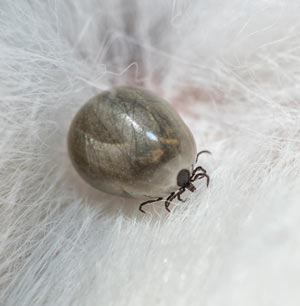Watch Out for Ticks This Year

It's spring, and in most areas of the country, that means it's time to start thinking about ticks. Because of this year's mild winter, these tiny biting pests have been more active than usual in much of the northern United States.
In fact, veterinarians at the Angell Medical Center in Boston have noticed a drastic increase in the number of tick-borne diseases that they have treated in dogs this fall and winter (Rocheleau, 2016).
Cold weather doesn't kill ticks; it only slows them down. Also, trapped under snow, it's harder for them to attach to a dog or person going past. With less snow and warmer overall temperatures this winter, pets and people have been outdoors more, and the ticks, not being as buried and sluggish, have had more opportunities to latch onto hosts.
Tick Increases and Movement
Over the past several years, veterinarians and parasitologists have noted that tick populations, in general, are increasing. The veterinarians at Angell Medical Center have also diagnosed illnesses in dogs that are transmitted by ticks that normally don't live as far north as Massachusetts, such as Rocky Mountain spotted fever, which is carried by the Lone Star tick.
The increase in tick numbers and species moving into different geographical areas may have to do with the fact that we are experiencing milder winters in general. It may also be related to increased development into more rural areas. People and dogs in places that never seemed to be affected by ticks before have been noticing a problem with them in recent years.
Ticks and Tick-Borne Diseases
Why should we be worried about an increase in tick numbers, species moving into new areas, or ticks being active at times of the year when they were previously more dormant?
Ticks are tiny parasites that feed on blood. They can attach to and drink from cats, dogs, humans, birds, and reptiles. They find their host by detecting motion, heat, and the carbon dioxide that is exhaled by their victims.
Various tick species can carry illnesses and transmit them while they are feeding. Some of these tick-borne diseases are Lyme disease, Rocky Mountain spotted fever, and babesiosis. It takes a period of at least several hours for a tick to transmit disease-causing microorganisms after it begins feeding. Unfortunately, because the biting pests secrete substances that anesthetize the area to which they attach, people and dogs almost never feel ticks biting them. Therefore, it is important to check yourself and your pets thoroughly whenever you come in from outside.
You will generally find ticks in secluded areas with lots of vegetation. Brush and wood piles are common hiding spots, too. It's common to pick ticks up while hiking or biking on trails or working in tall brush in your yard.
Repelling Ticks
The best way to avoid you or your pet developing a tick-borne disease is to elude tick bites as much as possible. Here are several things you can do to decrease the chances that you are your pet will be bitten by a tick:
- Remove brush piles, tall grass, and other tick hiding spots from your property.
- Treat your yard with insecticides. Check with local exterminators to determine the best insecticides to use for your area, how often they should be applied, and where to apply them. Be sure to carefully follow any instructions on the product for keeping your pets off the treated area after use. If there are not specific instructions, call the company and ask.
- Cover yourself up. When you are working in tall brush, hiking, or otherwise hanging out in areas that may contain ticks, be sure to wear long pants, tall boots, and long-sleeved shirts.
- Use tick repellent on your dogs. There are many options for this, so check with your veterinarian to determine the right one for your individual dog and your geographic area. Don't use any medications on your dog without checking with your veterinarian first. Be sure to follow the instructions on your chosen product carefully; it will need to be reapplied at intervals. Remember, just because you have tick repellent on your dog doesn't mean you won't ever see a tick on her. However, if a tick does make it onto your dog, most of these medications will kill it shortly afterward or once it attaches but before it can transmit diseases.
- Keep cats inside. There are far fewer safe options for repelling ticks from cats than there are for dogs. However, it is important to note that even keeping cats indoors doesn't guarantee they won't be bitten by ticks. The tiny pests are expert hitch-hikers and can find their way inside on your clothing or your dog's fur, drop off, and attach to your cat as he walks by. Talk with your veterinarian about whether your cat should have regular tick repellant applied and, if so, which one. Never use any flea or tick medication on your cat without checking with your veterinarian first! There are many products that can be used safely on dogs but are toxic to and can result in death in cats.
Removing a Tick
If you do find that a tick has attached itself to your dog, don't panic. The main thing to remember is that you don't want to traumatize the tick or squeeze its abdomen because that may cause it to release contents including infectious organisms into your dog.
Take a look at the article "How to Remove Ticks" to learn the best technique for removing an embedded tick from your dog. It's nice to have a tool such as Ticked Off available for this task.
You may wish to keep the tick alive in a sealed container so you can take it to your veterinarian or local health department to be identified. If the tick is a type that is known to carry a certain tick-borne illness, testing may be available to determine whether that particular tick was carrying it.
After a Tick Bite
After you have removed the tick from your dog and gently cleansed the area with warm water, it's important to keep an eye on that spot for a week or two. You may notice some mild redness and scabbing, but if the area becomes angry-looking, oozes, develops a hard bump, or your pet licks at it, you should visit the veterinarian right away. The site of the tick bite can become infected, so it's important to watch for complications.
Additionally, you should watch your pet for any signs that she may have developed a systemic illness from the tick's bite. Limping, anorexia, and lethargy can all be signs of various tick-borne diseases and are reasons for a veterinary visit. However, tick-borne illnesses can cause a huge variety of signs, so always check with your veterinarian if your pet is acting unusual in any way.
Works Cited
- Rocheleau, M. (2016, March 31). Our canine friends also need to watch out for ticks. Retrieved from BostonGlobe.com
You May Also Like These Articles:
Dog Fleas: How to Look for Fleas on Your Dog
Dealing With Canine Scratching and Licking
Bubonic Plague: The Role of Dogs in the Spread of Plague
Lick Granuloma: Causes, Treatments, and Prevention of Acral Lick Granuloma in Dogs
Are Dogs Ticklish? Why Do Dogs Kick Their Leg When You Rub or Scratch Them?
IVDD: Intervertebral Disc Disease in Dogs
Disclaimer: This website is not intended to replace professional consultation, diagnosis, or treatment by a licensed veterinarian. If you require any veterinary related advice, contact your veterinarian promptly. Information at DogHealth.com is exclusively of a general reference nature. Do not disregard veterinary advice or delay treatment as a result of accessing information at this site. Just Answer is an external service not affiliated with DogHealth.com.
Notice: Ask-a-Vet is an affiliated service for those who wish to speak with a veterinary professional about their pet's specific condition. Initially, a bot will ask questions to determine the general nature of your concern. Then, you will be transferred to a human. There is a charge for the service if you choose to connect to a veterinarian. Ask-a-Vet is not manned by the staff or owners of DogHealth.com, and the advice given should not delay or replace a visit to your veterinarian.



